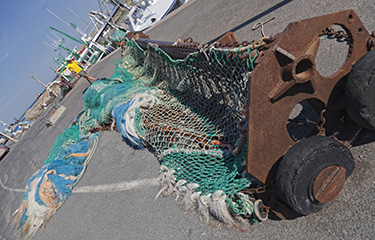Bottom-trawling – regarded as one of the most-destructive fishing methods – could be largely replaced in European Union fisheries by far less-aggressive, readily-available fishing gears, according to a new report published by ocean protection organizations Seas at Risk and Oceana.
The report, “Exploring Alternatives to Europe’s Bottom Trawl Fishing Gears,” found that bottom trawling is the main fishing method used across Europe, accounting for 32 precent of total E.U. landings, or 7.3 million metric tons (MT). But the practice is responsible for 93 percent of all reported discards, equating to 1 million MT between 2015 and 2019.
Replacing bottom trawls with any of the 25 other types of gear commonly used by E.U. fishing fleets, such as purse-seines, set-gillnets, pots, or traps would dramatically improve fisheries resources, the report found. Altogether, catches from gear other than bottom trawls represent 66 percent of total E.U. landings, but generally have less-damaging effects on the environment.
“Alternative, less-aggressive fishing gears could partly, and reliably, replace bottom-trawling in European waters. More importantly, replacing this harmful fishing gear would make a considerable difference for the health of our ocean and our future,” Seas at Risk Marine Policy Officer Andrea Ripol said. “The European Commission must seize this opportunity in their upcoming ocean action plan.”
The report acknowledges that alternative gears can have their own associated environmental problems, especially in terms of bycatch of sensitive species. Where such environmental impacts on sensitive species cannot be avoided with technical measures, rather than switching to these gears, Oceana and Seas at Risk recommend an overall reduction in the amount of fishing in those areas.
This report comes as the European Commission is about to publish its action plan to conserve fisheries resources and protect marine ecosystems, which is intended to set a path to tackle the impacts of fishing to meet the E.U.’s biodiversity objectives in the ocean.
“The destructive nature of bottom-trawling is no longer seriously disputed. The question is rather: when are we going to act on it?” Oceana Europe Campaign Director for Marine Protection Nicolas Fournier said. “Phasing out this destructive fishing method is essential to meet Europe’s biodiversity and climate targets, given its high fuel intensity, as well as the scale of its impact on marine life and on the carbon stored in the ocean floor. The European Commission must embrace this opportunity to shape a new vision of future low-impact, low carbon E.U. fisheries and prepare for this necessary transition now.”
A reduction of bottom trawling effort would benefit the marine environment and fish populations as many of the main species landed by bottom-trawlers, such as sandeels, sprat, and blue whiting, only tend to be used for aquaculture feeds and could be replaced by alternatives, the report said. Other species landed by bottom-trawls in large quantities, such as Atlantic cod, are severely overfished in Europe and would benefit from less-intensive fishing pressure, it said.
“Phasing out bottom-trawling that targets overfished populations and seafood for non-human consumption would be a good starting point to pave the way for a just transition to low-impact fisheries,” Ripol said. “While doing so, it is fundamental to safeguard the wellbeing of workers and communities currently dependent on bottom-trawling by providing income security or promoting the creation of alternative employment and retraining opportunities.”
Photo courtesy of riekephotos/Shutterstock







